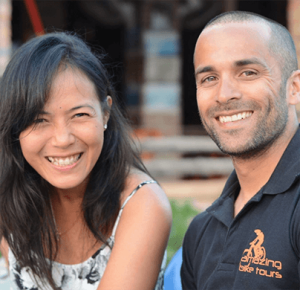Taiwan’s oldest city, Tainan, was the capital from 1683 to 1887, and remains rich in history. Known as ‘Taiwan’s Kyoto’, this ancient city has more Buddhist and Taoist temples than anywhere else in Taiwan, and holds an important position as a de facto gatekeeper of traditional culture. Explore centuries-old architecture, such as the well-preserved Dutch colonial Fort Proventia, and the 17th century Confucius Temple; meander through the university campus which is full of bookshops, cafés, and restaurants clustered in the leafy streets; and investigate Tainan’s growing reputation as top foodie destination.
Taroko National Park
Taroko National Park is Taiwan’s most popular tourist destination. A thrilling ascent along the steep winding Central Cross-Island Highway will take you to its heart, Taroko Gorge, an impressive natural wonder that is surrounded by treacherous cliffs and lush green forests. Taroko is best explored on foot and is a dream for hikers and wildlife-spotters. Trails such as Shakadang, Lushui and Zhuiliu Old Trail take you to the bottom of the Gorge, Swallow Grotto, Tunnel of Nine Turns, a high suspension bridge crossing the river, or to the Eternal Spring Shrine with its views of the mountains and waterfall.
National Palace Museum
The National Palace Museum in Taipei shares its roots with the Palace Museum of the Forbidden City in Beijing. It has a permanent collection of over 700,000 pieces of ancient and modern Chinese artefacts and artworks – the largest of its kind in the world. The vast number of artefacts means that it’s impossible to view all the pieces on a short visit, but there are several treasured and notable collections that must be seen. These are jade carvings including the superbly named ‘Jadeite Cabbage’ and ‘Meat-shaped Stone, the rare Ru ware ceramics, calligraphy and paintings such as Zhang Zeduan’s ‘Along the River During the Qingming Festival’.
Sun Moon Lake
Sun Moon Lake, nestled in the island’s central mountains, is an area of stunning natural scenery, and its high elevation offers a respite from the humidity of the summer in the cities. The area is inhabited by the Thao aboriginal people, who consider Lalu Island, located in the middle of the lake, as their sacred ground. Hiking and cycling trails provide active travellers with opportunities to explore the surrounding countryside, while the cable car will take you high above the lake for spectacular views. Tea plantations and teahouses are plentiful – visit them to try the aromatic Oolong tea.
Alishan National Scenic Area
Alishan in Chiayi County, home to the Tsou aboriginal people, is another of Taiwan’s majestic range of forested mountains, with a diverse array of flora and fauna. Famed for its spectacular sunrise and sunsets, Alishan is extremely beautiful during the cherry blossom season and autumn when the leaves turn red and gold. You can discover interesting aboriginal villages, high mountain tea plantations and waterfalls on hiking excursions. The area is home to Giant Formosan red cypresses, hence the construction the Alishan Forest Railway in 1912 for logging. Today the narrow-gauge train is now a tourist attraction, ferrying passenger from Chiayi to Fenqihu. Read more about the experience here…
Taipei 101
The iconic Taipei 101, formerly the Taipei World Financial Centre, in Xinyi District, is Taipei’s most famous landmark, comprising offices, a shopping mall and eateries. Construction began in 1999 and was completed in 2004, when it became the tallest building in the world – a title it conceded on the completion of the Burj Khalifa in Dubai in 2009. Its architecture marries modern engineering with Asian tradition, and the structure was designed to withstand typhoons and earthquakes. At its heart is the Tuned Mass Damper, an enormous pendulum that prevents Taiwan’s tallest building from swaying. Visitors can ascend to the Observation Deck for sweeping views of the city and the surrounding countryside.
Fo Guang Shan Monastery
The intriguing Fo Guang Shan Monastery in Kaohsiung is the headquarters of Fo Guang Shan, a Chinese Buddhist religious organisation founded by the monk Master Hsing Yun in 1967. The Monastery is an important pilgrimage centre for believers from Taiwan and overseas. It is also open to visitors who are curious to learn about monastic life and Buddha’s teachings. Daily tours led by monks and nuns will give a good introduction to Fo Guang Shan’s ethics and commitments to charitable endeavours, while overnight stays allow you to immerse yourself in this religious experience.
Jiufen & Yehliu
Jiufen is a small mountainside town located east of Taipei, and easily accessible by public transport. This charming town is a mecca for foodies and art lovers – its narrow alleyways are lined with street food stalls, teahouses with panoramic views of the mountains and ocean, and art studios showcasing works by local artisans. Easily combined with Jiufen is a visit to Yehliu, a cape known for its geological wonder of weirdly shaped hoodoo stones which can be viewed from Yehliu Geopark. The most outstanding of these include the ‘Queen’s Head’, one of the most recognised images of Taiwan, the ‘Fairy Shoe’, “Ginger Rocks’, ‘Sea Candles’ and the ‘Beehive’.
Qingshui Cliff
Qingshui (Chingshui) Cliff is a particularly majestic outlook on the scenic drive from Taipei to Hualien. Along the winding but picturesque Suhua Highway, with towering mountains on one side and the deep blue Pacific Ocean on the other, Qingshui’s sheer rock face plummets dramatically into the Pacific, creating 21km of coastal cliffs that rise 800m on average above sea level. The magnificent area around Qingshui has been designated as one of the Eight Wonders of Taiwan. A viewing pagoda provides a great vantage point to take in the impressive scenery.
Chiang Kai-Shek Memorial Hall
Taipei’s CKS Memorial Hall, as it’s also known, was erected in 1980 in honour of Generalissimo Chiang Kai-Shek, the father of modern Taiwan and former president of the Republic of China. The Memorial Hall is of national significance, and an important landmark that attracts local visitors and foreign tourists alike. The four sides of the Memorial Hall are white, contrasting with its blue, octagonal roof. Leading to the main hall are two sets of white stairs, each with 89 steps to represent the age of Chiang Kao-Shek at the time of his death in 1975. The hall houses a large statue of the general, and there is a museum which documents his life and career.
Ready to explore Taiwan?
Get in touch with our Taiwan Tour Specialists to discuss your travel plans.




